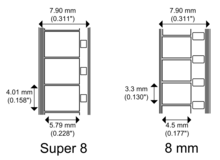Standard 8 mm film
The format was an immediate success, but retains a number of inherent problems and quirks, mostly connected with the fact that the spool needs to be removed and reversed halfway through filming.
This procedure is tricky for the inexperienced user and needs to be carried out in subdued light to avoid fogging of the edges of the film.
In reality, this was not the case, since the plastic pressure plate could be moulded to far smaller tolerances than their metal counterparts could be machined.
Finally, Super 8's smaller sprocket holes, while allowing a larger frame size, were also inherently more liable to tear.
Short, silent versions of sound films with dialogue titles added were also released, including W. C. Fields' The Bank Dick, which emphasized the chase sequence at the end of the movie.
The Walt Disney Studio released excerpts from many of their animated feature films, as well as some shorts, in both Standard and Super 8, some even with magnetic sound.
Standard 8 mm equipment was also manufactured by Carl Zeiss, Siemens & Halske Berlin, the Austrian firm Eumig, Fuji (as Fujica), and Canon, amongst others.
[3] As of November 2011[update], John Schwind, of International Film, is the only supplier for this "major US company" in the entire world.
In the Summer of 2003, John Schwind and Karl Borowski had the distinction of convincing Karen K. Dumont, an employee of this "major manufacturer" to produce the last new variant of type K-14 film stock ever coated, dubbed "Cine Chrome 40A."
Kodachrome's excellent archival qualities mean that old 8 mm film can still appear remarkably fresh if stored in the correct conditions.
The Straight Eight format, using pre-prepared 8 mm wide film, had some popularity in Europe, where Agfa manufactured their own stock.
Kodak eventually introduced a magazine-loading system, but it was never as popular as spooled 8 mm film and was discontinued by the early 1980s.
Some manufacturers (e.g. Pentacon in East Germany) made cameras with special magazines that could be pre-loaded with 8 mm spools.


